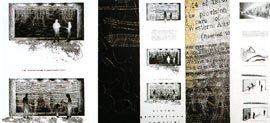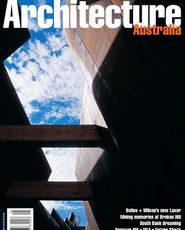



The revelations of the National Inquiry into the Separation of Aboriginal and Torres Strait Islander Children from Their Families – as published in the Bringing Them Home report (1997) – shocked many non-indigenous Australians. For those who are part of the Stolen Generations, the inquiry delivered their painfully familiar stories to the collective consciousness of the nation.
These revelations gave the process of reconciliation in Australia a certain urgency, the pivot of which became the apology.
Many Australians have said their sorries, some infamously have not. Many hope that saying “sorry” will provide closure, others think it is merely a beginning.
Melbourne Museum recently displayed the results of a national design competition which edges us towards a different kind of vocabulary for this moral restructuring of the nation – one that is formal, spatial, relational. This competition, managed jointly by Museums Victoria and the School of Architecture and Design at RMIT University, called for proposals for a memorial to the Stolen Generations.
This competition was philosophically underpinned by the idea of a “progressive memorial”. The brief was very precise about what this “anti-memorial” might be: interactive rather than dogmatic; ephemeral rather than permanent; modest rather than heroic; offering multiple interpretations rather than singular readings of history. In short, this “anti-memorial” was meant to challenge the traditional idea of the monument which, in the logic of the competition brief, is firmly aligned with power, force, and the imperial. Other, more pragmatic parameters flowed from this philosophical commitment: schemes had to be conceived as “temporary installations” for the museum building and/or precinct and realisable within the rather modest budget of $30,000.
Given these parameters, the competition solicited a relatively consistent range of responses. Entrants by and large kept to budget and diligently worked with the ideas of ephemerality, inter-activeness and anti-monumentality.
They also demonstrated a genuine sensitivity to the tragic history of forced removals. Most avoided drawing on stereotypes of Aboriginality in contemporary visual vocabularies – dots, curvilinear forms, and culture/nature folds – grappling instead with forms that better acknowledge the fact that the history of forced removals implicates Aboriginal and non-Aboriginal Australians alike.
Four schemes were commended. Liz Herbert produced an intriguing and solemn scheme consisting of a large folding cabinet for the museum’s forecourt. The cabinet would be ritualistically attended to each day, unfolded in the mornings to reveal, for all to read, thousands of perspex memorial tags engraved with information about individual children removed from their families. At close of day this cabinet would then be folded away, leaving a sombre box mutely inhabiting the forecourt. Annabel Stanton and Damien Pericles proposed an interactive installation consisting of hessian printed with extracts from protectionist policies overlaying a more permanent surface covered with Stolen Generation stories.
Museum visitors would be invited to remove strands of the hessian overlay and in so doing literally unravel an official history to reveal hidden emotional truths. This scheme quite literally would invite visitors to worry at and about the nation’s past. Rosanne Barley and Damien Wright proposed an installation of a finely crafted set of wood memorial boxes lined with bands of silver into which are incised relevant words. The way visitors could interact with these boxes was less scripted: they might be touched, climbed through or simply looked at. Renee Romyn, wittily toying with suburban Australia’s obsession with lawn, literalised the experience of uprooting through her work.
She proposed a text-based installation around Archie Roach’s song “Took the Children Away”, to be located in the museum forecourt. The scheme takes letters cut from the turf of the surrounding parklands and assembles them into manicured stacks. Visitors would then be invited to return these stolen lawn-letters to their places of origin.
This competition has provided a welcome opportunity for exploring the language of such awkward memorywork. A notable feature of the entries generally – including the four commended schemes – was an inclusion of words, whether in the form of an extract of the official policies of the time, or a snippet of a heartbreaking testimonial from a member of the Stolen Generations. Indeed, within the various strategies on show in this exhibition, the text often carries the most substantial memorialising responsibility. What might account for this reliance on text? It is certainly true that most (non-indigenous) Australians have come to “feel” the experience of the Stolen Generations vicariously through texts such as Bringing Them Home. These accounts appear to have weighed heavily upon the design language deployed in these schemes. A text-based strategy also offers a convenient way of addressing the anti-monumental aims of the competition brief. It generates intimate, interactive, personal and contemplative effects.
But what is being gained and what is being lost by the presumption that this memorywork needs to be anti-monumental?
Must a postcolonial memorial be denied hard monumental expression? Does the language of healing have to be formed through the intimately ephemeral? Do these assumptions enrich or impoverish our forms of remembrance? Can such anti-memorials produce the kind visceral effects that would be needed to register the violence and the pain? The politeness of these diminutive, impermanent installations leads us to wonder who exactly is meant to be the beneficiary of these rememberings? If coming to terms with the tragedy of the Stolen Generations is so central to a reconciled Australia, then why is it that we lack the courage to imagine something permanent and heroic? These qualities are not the sole domain of the imperial, just as emotional solace does not have to belong to the small spaces of individual interaction.
Dr Jane M. Jacobs is associate professor of cultural geography at the University of Melbourne. Dr Stephen Cairns is a senior lecturer in architecture at the University of Melbourne.















